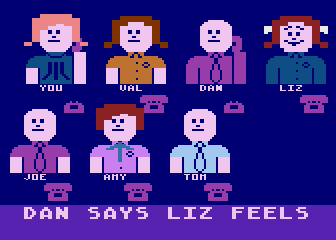Gossip (video game)
| Gossip | |
|---|---|
 | |
| Developer(s) | Atari |
| Publisher(s) | Atari Program Exchange |
| Designer(s) | Chris Crawford |
| Platform(s) | Atari 8-bit computers |
| Release date(s) | 1983 |
| Genre(s) | Art game |
Gossip was an experimental video game created for the Atari 8-bit family by Chris Crawford. Crawford wished for video games that would simulate aspects of human social interaction via “social challenges”. He hoped these "people games" would appeal to those who were not interested in the more common gaming genres of combat and sports.
Although the social interactions in Gossip are relatively simple, Crawford contends that they are comparable to the level of complexity found in The Sims.
Interface
The screen at right is a mock-up that Crawford contributed. In High Score!: The Illustrated History of Electronic Games (ISBN 0-07-222428-2), an actual screen shot appears with different colours and eight characters: You, Val, Jim, Liz, Amy, Dan, Sue and Tom.
The player would use a joystick cursor to select a character to telephone. That person’s phone would ring with a jiggling animation and ringing sound effect. He or she would pick up the phone and say, “Air-oh?” The player would select a person to gossip about, and then one of five expressive animations (strong positive, slight positive, neutral, slight negative, strong negative). The listener would then respond with his or her own opinion of the person.
Social model
The social interactions he chose for this experimental simulation were declarations of affinity (e.g. “I like Fred,” “I hate Jane”). The theory behind the simulation was that people liked those who shared their opinions of others, and were also influenced positively by their friends’ opinions and negatively by their enemies’ opinions. Such declarations, Crawford said, were implicit in many pieces of gossip. He produced the following mathematical model:
where xa,b is a’s actual opinion of b, x'a,b is a’s declared opinion of b, l is the listener, s is the speaker, o is the object (the person being gossiped about), k1 and k2 are constants greater than 1 (Crawford gave the hypothetical value of 10, but did not specify the actual values used in the game).
The AI characters did not perform discrete interactions with each other. They instead acted as nodes in a web of springs, trying to reduce the tension around them. The original game engine was written in Atari BASIC and took hours to complete the calculations for a single turn. Two major attempts were made to rewrite the system in assembler language, which reduced the calculation time to a few moments.[1]
One issue that was not addressed was sincerity. Also, it did not account for the fact that repeating the same statement too many times would eventually reduce its effect.
Commercial results
Although Crawford was particularly proud of this game, he never developed a structure of goals (making it, by his definition, a toy rather than a game) and never published it. The two developers that worked on the assembler versions had a different opinion, calling it boring. Although they raised this point during development, it was said that Crawford would simply state that if they understood the concept they would know it would be fun. One of the developers quit the project due to this attitude.[1] Only a few cartridges were produced, and fewer still (the exact number is uncertain) ever sold, and they are now rare collector’s items.
Nonetheless, he applied this experimental system in Excalibur, for the management of the Knights of the Round Table and diplomacy with the other kings of England. In the former case, affinity was declared by giving gold, bestowing honours that would diminish the value of other honours, and banishing a knight. In the latter case, it was by demanding tithes, paying them and attacking. He also took the idea of social challenge into a different mechanic with Trust and Betrayal: The Legacy of Siboot.
References
- 1 2 Savetz, Kevin (10 December 2015). "ANTIC Interview 104 - Aric Wilmunder, Star Raiders II, Temple of Apshai" (Podcast).
Crawford, Chris (2003). "Chapter 19: Gossip". Chris Crawford on Game Design. New Riders. ISBN 0-88134-117-7.
External links
- atariarchive.org Gossip info